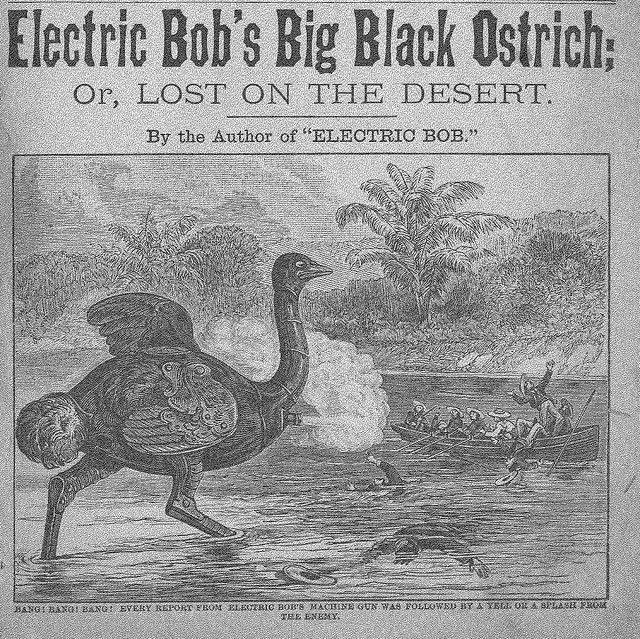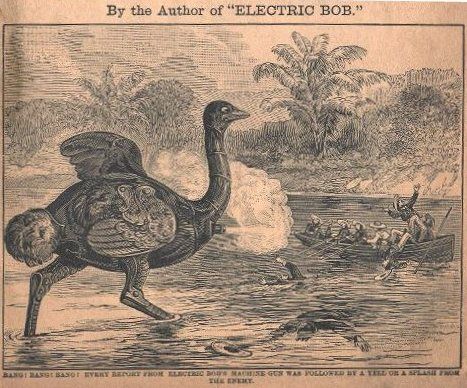
Electric Bob. Image courtesy Joe Rainone.
Electric Bob was introduced in "Electric Bob and His White Alligator; or, Hunting for Confederate Treasure in the Mississippi River" in the New York Five-Cent Library v1 n50 (July 22, 1893) by "Robert T. Toombs," an author about whom nothing is known. E.B. appeared in "Electric Bob's Big Black Ostrich; or, Lost on the Desert" (1893); "Electric Bob's Revenue Hawk; or, the Young Inventor among the Moonshiners" (1893); "Electric Bob's Big Bicycle; or, the Nerviest Boy in the World" (1893), and "Electric Bob's Sea-Cat; or, the Daring Invasion of Death Valley" (1893). Electric Bob was in the second rank of boy inventor characters; never as popular as Frank Reade Jr. or Jack Wright, he nonetheless had a certain cachet for readers in the early 1890s and was popular enough for his adventures to appear in magazines like the New York Five Cent Library and Brave and the Bold. Because of this, his stories are very hard to find, but not impossible, and are worth the effort, since Toombs wrote them with a certain wit, levity, and a whimsical, tongue-in-cheek tone that is absent from the other boy inventors' adventures. In one story, for example, it is implied that Bob spends the night with a Lady Of Negotiable Affection in Chicago. (We're not likely to see Frank Reade, Jr. doing that) It might reasonably be concluded that the entire Electric Bob series is a satire of the boy inventors subgenre.
Electric Bob is a 10-year-old who lives near (but not in) New York City. He's brilliant, of course, and capable of creating the most advanced technology possible, but unlike the other boy inventors he does not build his own equipment and weaponry; he draws up the blueprints in very detailed fashion and then sends them to the most efficient and skillful shops to construct for him. (He apparently patents them ahead of time, so he does not have to worry about his creations being stolen) Although, like Reade Jr. and Wright, he creates the usual electric weaponry and equipment, his specialty is vehicles in the form of animals. The exception is is Big Bicycle, which is electrically-operated with a canopy, storage space for food and equipment, steel-covered tires; its only weapon is that it can be electrified, but Bob also carries his "electric pistol," which shoots lethal bullets at extremely high speeds. Bob also wears a coat of bullet-proof armor under his clothing. His other vehicles are the sea-going "White Alligator," the land-roving "Big Black Ostrich," the flying "Revenue Hawk," the submarine Sea-Cat (the only vehicle Bob names, unlike Reade Jr. and Wright), and the land-roving "Desert Camel." They fall into the same general Marvelous Invention pattern, being armored, durable, stocked with supplies, and capable of traversing rough terrain and enduring harsh weather and conditions. Bob, of course, has the usual diving suits with oxygen packs and one-man flying suits (flapping wings powered by electric batteries). Bob is a more upbeat and joyful character than the priggish Reade Jr., and his servant Dandy, despite being saddled with the usual racist epithets, is shown more respect than is usually the case with boy inventor dime novels. Similarly, non-whites are not, by and large, the victim of most of Electric Bob's weaponry; white men (West Virginia moonshiners, Mississippi swamp rats, Yankee swindlers) generally are. All in all, the Electric Bob novels are much superior to the other boy inventor novels.
[Text sourced from here.]
